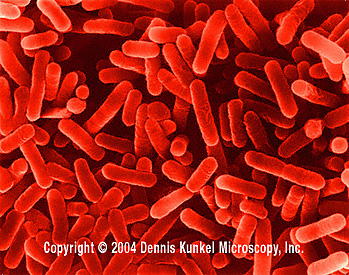
This webpage was produced as an assignment for an undergraduate course at Davidson College.
Evasion of Immune Response
Legionella pneumophila is able to evade the host immune system because of its unique life cycle. Only 0.5 log of those bacteria phagocytosed are actually lysed by the host cell (Fraser, 1986). The rest of the L. pneumophila uses the intracellular compartment as a safe replication center. These bacteria spend the majority of their replicative stage inside of a host phagosome. This unique position protects them from the cells of innate immunity and denies the cell-mediated immunity and humoral immunity a chance to be activated. From this location, L. pneumophila increases their security and begins to overtake the host cell by attracting organelles and inducing autophagy. Finally, the bacteria begin their replicative stage and eventually lyse the cell membrane, beginning the process anew (Swanson, 2007).
Attraction of Organelle/Induction of Autophagy
Once inside the phagosome, L. pneumophila is not completely safe from the immune system. Like all other pathogens taken up by a macrophage it should be fused with a lysosome and killed by the degradative enzymes. L. pneumophila, though, somehow manages to avoid lysosome fusion by using a mechanism that is not understood (Swanson et al., 1995). After successfully avoiding the lysosome the phagosome containing the bacteria is surrounded by ribosomes, mitochondria, and endoplasmic reticulum (ER). These organelles appear within fifteen minutes of phagocytoses and are likely attracted by chemokines emitted by the pathogen (Molmeret et al., 2004).
The surrounding host organelles provide safety from the immune system, but are quickly phagocytosed by the captive macrophage. This action, known as autophagy, is likely caused by chemokines emitted by the L. pneumophila that signal the macrophage to engulf anything in range, including host organelles (Swanson et al., 1995). Autophagy occurs up to twelve hours after the initial phagocytosis of the pathogen (Molmeret et al., 2004).

Transmissive L. pneumophila after lysing the host cell. Image used with permission: Copyright Dennis Kunkel Microscopy, Inc.
Replicative Stage and Lysis of Host
Autophagy provides the raw material for the replication of the invading bacterial cells. The host peptides and amino acids that result from the meeting of the organelles and the lysosomes are used in the replication of the L. pneumophila (Swanson et al., 1995). The replicative stage continues indefinitely until the bacteria continue their infection. Starting at twelve hours and up to eighteen hours the bacteria begin to lyse the macrophage and move into the cytoplasm. L. pneumophila seem to be unable to replicate in most cytoplasm, including that of epithelial cells, and therefore must infect new macrophages in order to continue the infection (Molmeret et al., 2004). This continued infection comes between eighteen and twenty-four hours when the pathogenic cells lyse the plasma membrane and seeks a new cell to infect (Molmeret et al., 2004).
Works Cited
Fraser DW. 1986. The peculiarities of “Legionella”. Proceedings of the American Philosophical Society 130:330-335.
Molmeret M, Bitar DM, Han and YA Kwaik. 2004. Disruption of the phagosomal membrane and egress of Legionella pneumophila into the cytoplasm during the last stages of intracellular infection of macrophages and Acanthamoeba polyphaga. Infection and Immunity 72(7):4040-4051.
Swanson, M. Updated 2007 February 2. Michele Swanson: University of Michigan Department of Microbiology and Immunology. <http://www.med.umich.edu/microbio/bio/swanson_m.htm>. Accessed 2007 February 12.
Swanson MS and RR Isberg. 1995. Association of Legionella pneumophila with the macrophage endoplasmic reticulum. Infection and immunity 63(9):3609-3620.